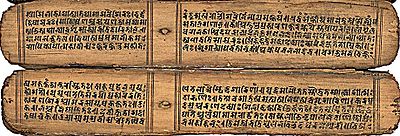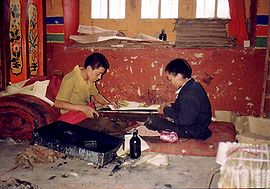
Pecha
Encyclopedia
Pecha is a Tibetan
word meaning "book", but in particular, refers to the traditional Tibetan loose-leaf books such as the kangyur
, tengyur
, and sadhana
s. Pechas sometimes have top and bottom cover plates made of wood, cardboard, or other firm materials, and are often seen wrapped in cloth for protection. The word pecha has entered common use in other languages such as English in the Tibetan Buddhist community, evident online in discussion forums and softwa|re |products that include the word in their names.
 Pechas trace their history and unique shape back to the palm leaf manuscript
Pechas trace their history and unique shape back to the palm leaf manuscript
s of India where palmyra
and talipot palm leaves were used in the creation of texts as early as the 500 BCE. The earliest existing palm leaf manuscripts date from 200 C.E. and were in continuous use until the 19th century.
The migration of India's manuscript technology to Tibet took place around the 7th century, when the scholar Thonmi Sambhota
created the Tibetan script from his studies in India and Kashmir (his work is believed to be based on the Indian Brahmi and Gupta scripts). This script was then used to translate Buddhist Sanskrit texts into Tibetan. However, with the lack of traditional palm leaves in Tibet, birch bark was used instead; the use of bark was eventually supplanted by paper.
 Though digital copies of pechas are prevalent, and software exists to create them, physical reproductions by woodblock
Though digital copies of pechas are prevalent, and software exists to create them, physical reproductions by woodblock
are still common. In monasteries that support woodblock printing, monks will work in teams of two. One will roll the woodblock with ink, then the other will place a blank long sheet of paper, which is then pressed by the first monk.
Tibetan Buddhist temples and shrine rooms traditionally house a complete collection of the kangyur
and tengyur
in pecha form. These are individually wrapped in cloth and tagged with brocade markers at one end and then placed upon shelves on the shrine.
Standard Tibetan
Standard Tibetan is the most widely used spoken form of the Tibetan languages. It is based on the speech of Lhasa, an Ü-Tsang dialect belonging to the Central Tibetan languages. For this reason, Standard Tibetan is often called Central Tibetan...
word meaning "book", but in particular, refers to the traditional Tibetan loose-leaf books such as the kangyur
Kangyur
The Tibetan Buddhist canon is a loosely defined list of sacred texts recognized by various schools of Tibetan Buddhism, made up of the Kangyur or Kanjur and the Tengyur or Tanjur .-The Tibetan Buddhist Canon:In addition to earlier foundational Buddhist texts from early Buddhist schools, mostly...
, tengyur
Tengyur
The Tengyur or Tanjur is the Tibetan collection of commentaries to the Buddhist teachings, or "Translated Treatises"...
, and sadhana
Sadhana
Sādhanā literally "a means of accomplishing something" is ego-transcending spiritual practice. It includes a variety of disciplines in Hindu, Sikh , Buddhist and Muslim traditions that are followed in order to achieve various spiritual or ritual objectives.The historian N...
s. Pechas sometimes have top and bottom cover plates made of wood, cardboard, or other firm materials, and are often seen wrapped in cloth for protection. The word pecha has entered common use in other languages such as English in the Tibetan Buddhist community, evident online in discussion forums and softwa|re |products that include the word in their names.
History

Palm leaf manuscript
Palm leaf manuscripts are manuscripts made out of dried palm leaves. They served as the paper of the ancient world in parts of Asia as far back as the fifteenth century BCE. and possibly much earlier. They were used to record actual and mythical narratives in South Asia and in South East Asia...
s of India where palmyra
Borassus
Borassus is a genus of six species of fan palms, native to tropical regions of Africa, Asia and New Guinea. They are tall palms, capable of growing up to 30 m high. The leaves are long, fan-shaped, 2 to 3 m in length...
and talipot palm leaves were used in the creation of texts as early as the 500 BCE. The earliest existing palm leaf manuscripts date from 200 C.E. and were in continuous use until the 19th century.
The migration of India's manuscript technology to Tibet took place around the 7th century, when the scholar Thonmi Sambhota
Thonmi Sambhota
Thonmi Sambhota [bhrahmi samhita; localized form of ]is traditionally regarded as the creator of the Tibetan script and author of the Sum cu pa and Rtags kyi 'jug pa in the 7th century AD. Thonmi Sambhota is not mentioned in any of the Old Tibetan Annals or other ancient texts, although the Annals...
created the Tibetan script from his studies in India and Kashmir (his work is believed to be based on the Indian Brahmi and Gupta scripts). This script was then used to translate Buddhist Sanskrit texts into Tibetan. However, with the lack of traditional palm leaves in Tibet, birch bark was used instead; the use of bark was eventually supplanted by paper.
In Tibetan Buddhism

Woodblock printing
Woodblock printing is a technique for printing text, images or patterns used widely throughout East Asia and originating in China in antiquity as a method of printing on textiles and later paper....
are still common. In monasteries that support woodblock printing, monks will work in teams of two. One will roll the woodblock with ink, then the other will place a blank long sheet of paper, which is then pressed by the first monk.
Tibetan Buddhist temples and shrine rooms traditionally house a complete collection of the kangyur
Kangyur
The Tibetan Buddhist canon is a loosely defined list of sacred texts recognized by various schools of Tibetan Buddhism, made up of the Kangyur or Kanjur and the Tengyur or Tanjur .-The Tibetan Buddhist Canon:In addition to earlier foundational Buddhist texts from early Buddhist schools, mostly...
and tengyur
Tengyur
The Tengyur or Tanjur is the Tibetan collection of commentaries to the Buddhist teachings, or "Translated Treatises"...
in pecha form. These are individually wrapped in cloth and tagged with brocade markers at one end and then placed upon shelves on the shrine.
Pecha Software
The following software products can be used for generating pechas in either electronic form or for printing as physical Tibetan books.- PechaMaker - free, closed source code
- TibetDoc - commercial
- Pecha Publisher - free, open source (not complete)
See also
- Talipot palm
- Palmyra PalmBorassusBorassus is a genus of six species of fan palms, native to tropical regions of Africa, Asia and New Guinea. They are tall palms, capable of growing up to 30 m high. The leaves are long, fan-shaped, 2 to 3 m in length...
- Palm leaf manuscriptPalm leaf manuscriptPalm leaf manuscripts are manuscripts made out of dried palm leaves. They served as the paper of the ancient world in parts of Asia as far back as the fifteenth century BCE. and possibly much earlier. They were used to record actual and mythical narratives in South Asia and in South East Asia...
- Woodblock printingWoodblock printingWoodblock printing is a technique for printing text, images or patterns used widely throughout East Asia and originating in China in antiquity as a method of printing on textiles and later paper....

